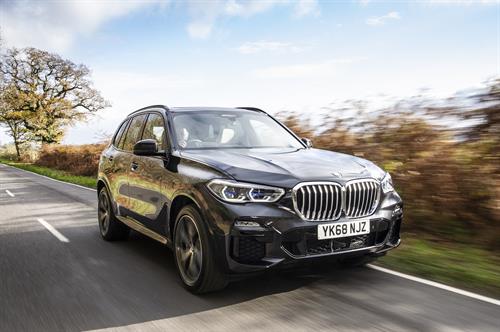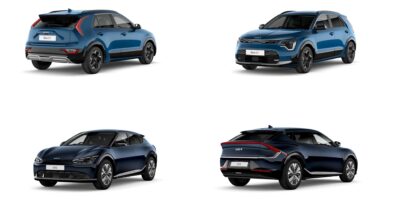BMW is once again setting the standard for the Sports Activity Vehicle with the new fourth-generation X5. Combining an elegant and strong design with supreme on-and off-road ability, the new X5 has an even greater blend of premium luxury performance and comfort. It’s a winning formula with previous generations selling in excess of 2.2 million examples since the first X5 launched in 1999.
On sale in the UK from June 2018, the all-new X5 demonstrates the latest BMW advances in technology, design and safety, with the highest level of autonomous capability yet seen on a BMW X model. A choice of TwinPower and M Performance petrol and diesel engines are matched to a new eight-speed Steptronic gearbox and the latest version of xDrive for maximum comfort, capability and performance.
Design.
With a wheelbase 42mm longer than its predecessor, an increase in vehicle length of 36mm, an extra 66mm of width and a 19mm increase in height, the new BMW X5 has both an imposing appearance and generous levels of space for passengers and their luggage.
Distinctive design features mark out the xLine and M Sport model variants of the new X5. The xLine model adds kidney grille bars in aluminium matt, roof rails and side window surrounds in satin Aluminium, plus other accents in Pearl-effect Chrome. M Sport specification, meanwhile, sees the wheel arch trim, bumper trim, rear underguard and side skirts painted in body colour, plus extra-large air intakes at the front end, aluminium matt kidney grille bars. The roof rails, side window surrounds and other trim elements in high-gloss black flag up the dynamic potential of the SAV.
The new BMW X5 comes as standard with 19-inch light-alloy wheels on the xLine model, 20-inch M star-spoke light-alloy wheels on the M Sport model and exclusive 22-inch V-spoke alloy wheels on the M Performance model. Further variants in 20 to 22-inch formats are available as options.
Powertrain and driving experience.
There will be one petrol and two diesel units available from the latest generation of engines. The BMW X5 M50d is powered by a six-cylinder in-line diesel engine with four turbochargers. A six-cylinder inline unit powers the BMW X5 xDrive40i and BMW X5 xDrive30d. All engines channel their power through an eight-speed Steptronic transmission, while BMW xDrive intelligent all-wheel drive is on hand to ensure that power is translated into secure progress – on or off road.
The BMW TwinPower Turbo technology package for the petrol engines comprises turbochargers, High Precision Injection, VALVETRONIC fully variable valve timing and Double-VANOS variable camshaft timing. On the diesel side, the raft of technological measures at work includes turbochargers and common-rail direct injection with piezo injectors. The result is instantaneous pulling power and sporty performance credentials with exemplary fuel consumption and emissions. All model variants comply with the requirements of the EU6d-TEMP emissions standard. The system of emission control for the petrol engines includes a gasoline particulate filter, while the diesel models boast BMW BluePerformance technology comprising a particulate filter, an oxidation catalyst, a NOx adsorption catalyst and an SCR catalyst with AdBlue injection.
The power unit fitted in the new BMW X5 xDrive40i enjoys free-revving ability and eager response. The 3.0-litre unit employs a twin-scroll turbocharger and direct petrol injection technology with a maximum pressure of 350 bar. The straight-six generates its maximum output of 340hp, while the peak torque of 450Nm is available. The new BMW X5 xDrive40i completes the zero to 62mph sprint in just 5.5 seconds. Fuel consumption averages 33.2mpg and CO2 emissions are 193g/km.
The performance of the new BMW X5 M50d is provided by the potent engine at work under its bonnet. From its 3.0-litre displacement the BMW M Performance model’s six-cylinder in-line unit delivers a peak output of 400hp and generates maximum torque of 760Nm.
These figures are possible thanks to a multi-stage turbocharging system composed of two high-pressure and two low-pressure turbochargers delivering over 450Nm of torque. In normal driving situations, both low-pressure turbochargers and one of the two high-pressure units are permanently active. The second high-pressure turbocharger only joins in when the engine speed tops 2,500rpm. Under hard acceleration from idle, flaps are adjusted so the pair of low-pressure turbochargers can be swiftly bypassed, thereby generating maximum charge pressure with even less delay. To boost the turbocharging system’s efficiency, exhaust gas recirculation is employed for both the high-pressure and low-pressure stages and the common-rail direct injection system capable of generating pressures in excess of 2,500 bar. The new BMW X5 M50d darts to 62mph from rest in 5.2 seconds yet it succeeds in posting a combined fuel consumption of 41.5mpg and CO2 emissions of 179g/km.
The new BMW X5 xDrive30d is also powered by a straight-six diesel engine, this time with displacement of 3.0 litres and featuring a single turbocharger with variable inlet geometry. The common-rail direct injection system propels fuel into the combustion chambers at up to 2,500 bar. Maximum output of 265hp, while offering 620Nm of torque. Capable of reaching the 62mph mark from rest in 6.5 seconds, the new X5 xDrive30d returns combined fuel consumption of just 470mpg, equating to CO2 emissions of 158g/km*.
| Model | Power (hp) | Torque (Nm) | 0 – 62mph (Seconds) | Top Speed (mph) | Combined (mpg) |
CO2 Emissions (g/km) |
From (OTR) |
| X5 xDrive40i xLine |
340 | 450 | 5.5 | 151 | 33.2 | 193 | £58,885 |
| X5 xDrive30d xLine |
265 | 620 | 6.5 | 143 | 47.1 | 158 | £57,495 |
| X5 M50d | 400 | 760 | 5.2 | 155 | 41.5 | 179 | £71,475 |
*Electronically limited
** All figures are provisional
All of the engines available for the new BMW X5 come with a new, improved version of the eight-speed Steptronic transmission, whose wider ratio spread and new control electronics help to increase the powertrain’s overall efficiency. New torsion dampers reduce rotational irregularities and converter slip for superior shift comfort, while optimised hydraulic control enables even sportier gear shifts.








